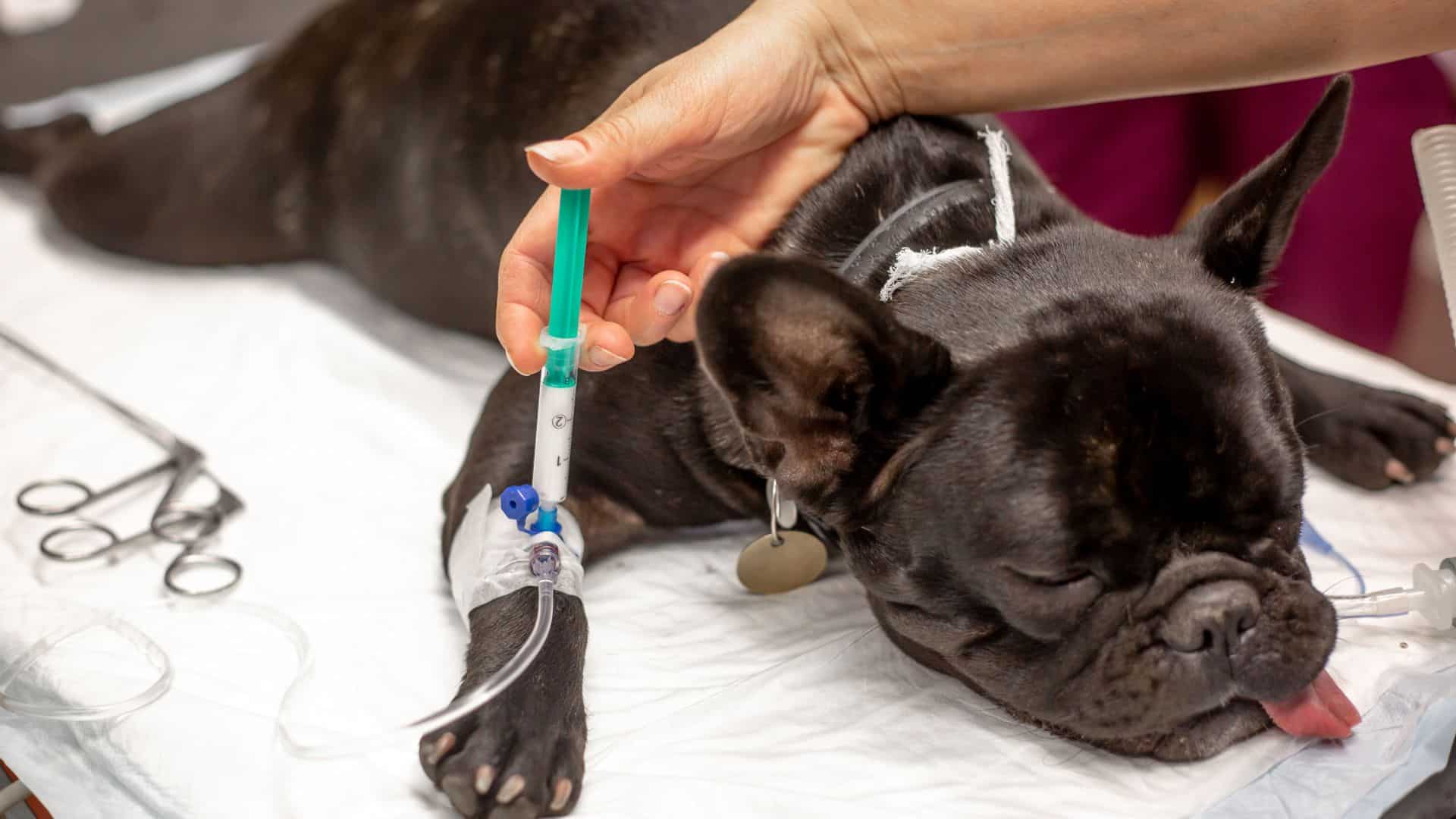When you own a dog, it is very important to know everything about how to keep him in the perfect shape, happy, and healthy. We all want our pups to be in our life for as long as possible, right?
However, many dog owners, especially first-time owners, don’t actually know when their doggies are overweight, which is very concerning.
Not only is obesity bad for them on its own, but it can actually cause many other serious health issues that can significantly affect their lifespan.
So, if you are one of those people who has been asking themselves, “how heavy should my dog be?”, today’s your lucky day because we present you with the ultimate guide on how to take care of your dog and keep him healthy.
How Heavy Should My Dog Be?
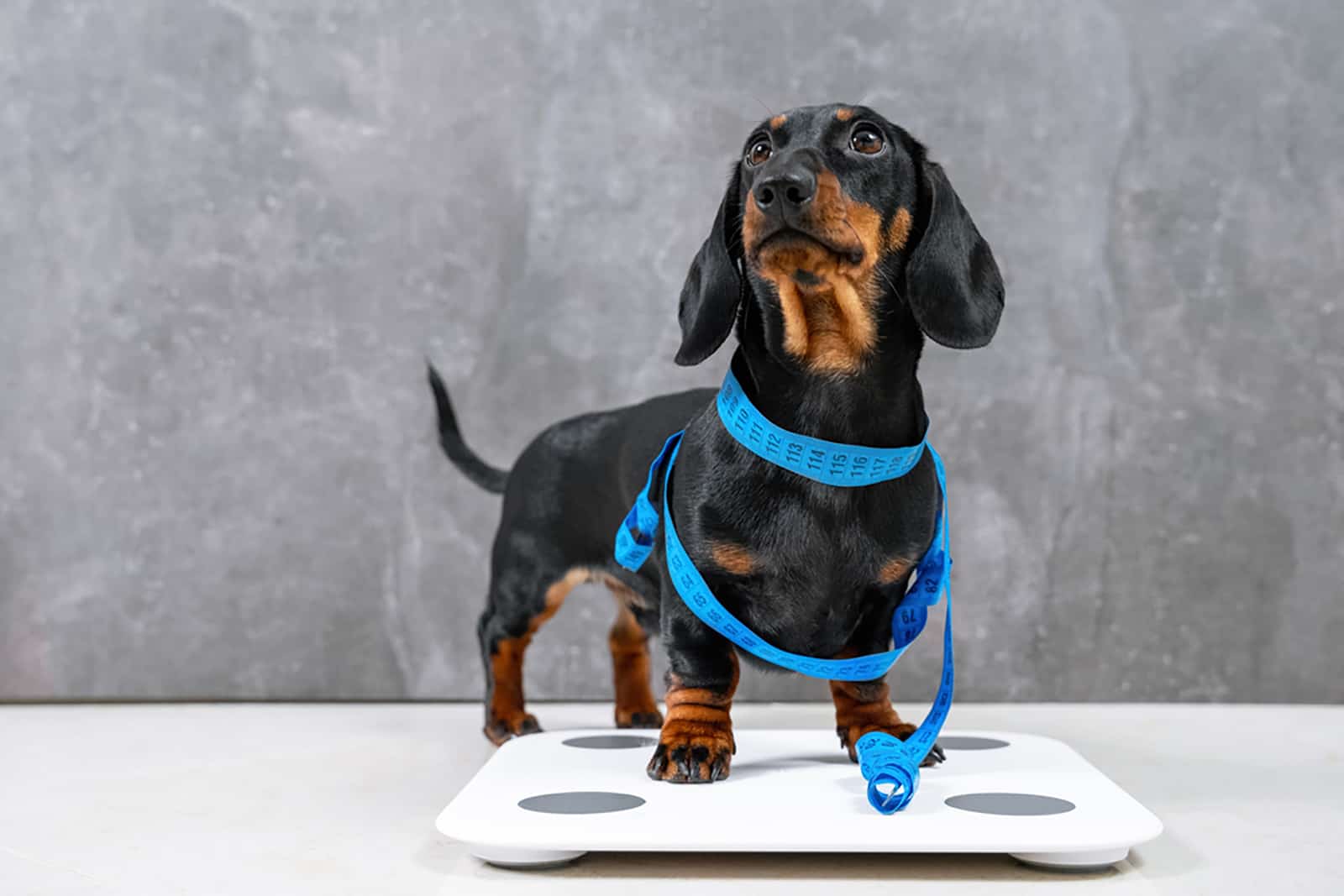
Healthy body weight is not only important for humans, but also for our furry friends. Although we prefer our pooches to be a little bit chunky because they look cuter, this is actually not good for them.
It affects their lifestyle, and can cause many issues along the way.
So, I am sure that a lot of us have asked ourselves this question: “how heavy should my dog be?!” The answer is not that simple, actually.
You might already know that there are a lot of different dog breeds: small, medium, large, and giant breeds, and it is quite obvious that a Great Dane cannot have the same ideal body weight as a small-breed Chihuahua.
The average dog weight differs greatly for different dog breeds, and the situation gets even more complicated when we introduce mixed-breed dogs into the picture.
The average weight of a mixed puppy might not be the same as one of their purebred parents.
However, there are two more factors that are even more important when it comes to calculating a dog’s ideal weight — the size and the age of the dog.
Some other factors, like gender and desexing age will also affect your dog’s size and weight. For example, female dogs are said to be smaller than male dogs, and therefore, they weigh less.
Dogs that are neutered/spayed at a younger age usually grow taller than those that are neutered later on.
Related: 9 Signs Your Dog Needs To Be Neutered
Body Condition Score (BCS)
When determining whether a dog is overweight or underweight, or has an ideal weight, most professionals use something that is called the Body Condition Score as this is the most accurate way to measure a dog’s weight.
The Body Condition Score (BCS) is a quantitative method of evaluating a dog’s body weight, and it is used by veterinarians and dog food manufacturing companies.
It is something similar to the Body Mass Index (BMI) that humans use; however, it is much more complicated than the human version.
Even though humans also come in various shapes and sizes, the canine world is much more diverse, and therefore, needs an adequate measuring system. The BCS uses physical characteristics to determine the dog’s body condition.
Currently, there are two BCS scales that are being utilized:
• BCS 5-point scale
• BCS 9-point scale
Some veterinarians prefer the 9-point scale because it offers more diversity and range in order to identify even the slightest changes in weight, while others, on the other hand, prefer the 5-point scale because of the fewer categories and because it is easier to use.
It is important to note that both scales are perfectly fine to use, and they will both give you correct answers. It is just a matter of preference. However, a 5-point scale will be much easier to use for regular pet owners.
BCS 5-point Scale
1/5 — Very thin
2/5 — Underweight
3/5 — Ideal weight
4/5 — Overweight
5/5 — Obese
BCS 9-point Scale
1/9 — Emaciated
2/9 — Very thin
3/9 — Thin
4-5/9 — Ideal weight
6/9 — Overweight
7/9 — Heavy
8/9 — Obese
9/9 — Severely obese
Ideal Weight
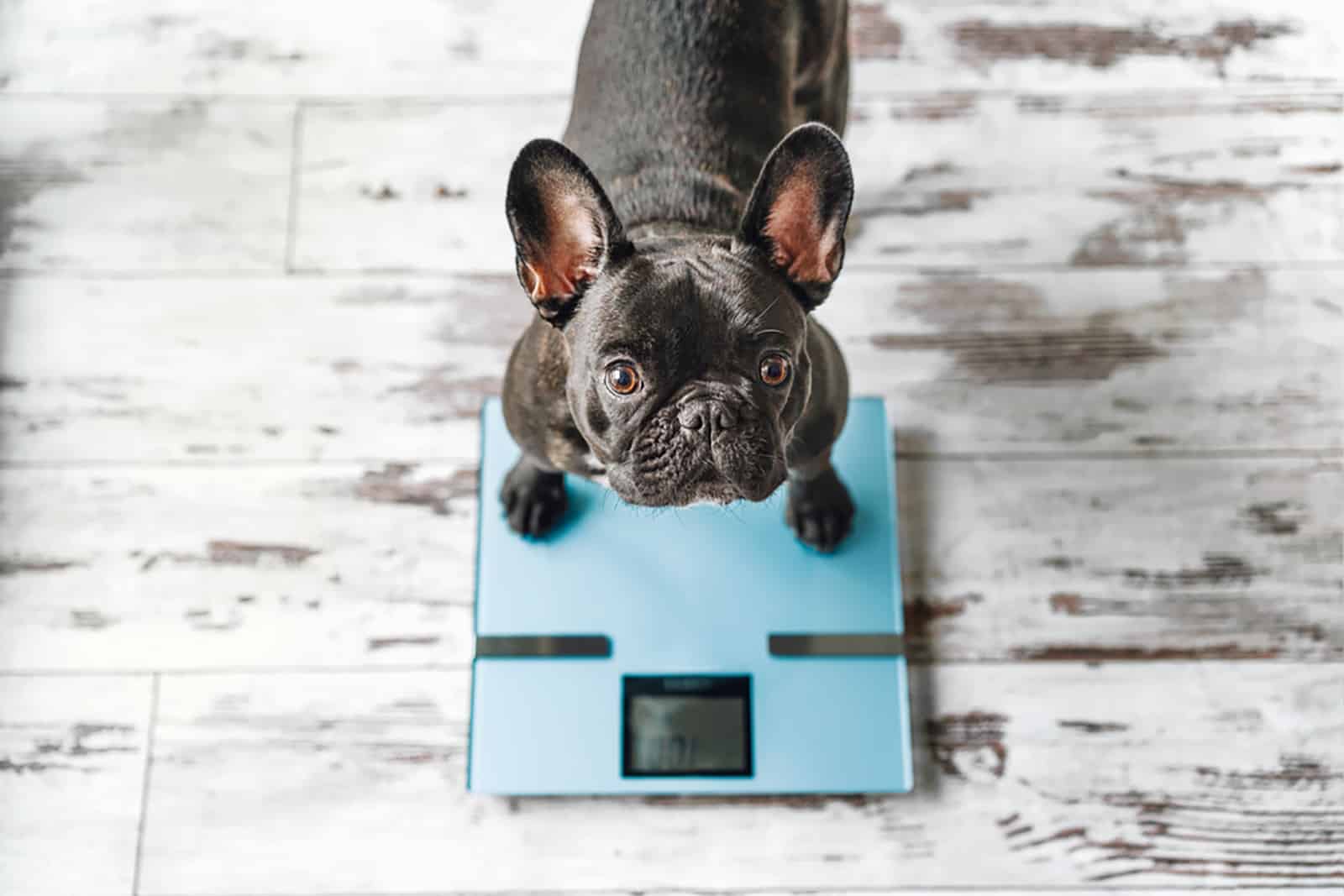
As you might have seen on the chart above, the dog’s ideal weight is 3/5 (or 4-5/9). But, how do we get to these numbers, and what exactly do they mean?
In order to assign your dog a certain score, you will need to engage in two activities: visualization and palpation.
You first need to look at your dog from above and determine whether he has an hourglass figure, then look at your dog from the side and pay attention to his tummy.
A tummy tuck, a saggy belly, or an abdomen that slants upwards — these are all that you have to pay attention to. You will also need to try to feel your pup’s ribs.
If your dog is healthy, you should be able to easily feel his ribs.
If you are confused about what should be normal, this is best compared to feeling the knuckles of your hand when your hand is resting on some flat surface.
So, what is the dog’s ideal weight?
When you look at your dog from above, he or she should have a clear waist.
There shouldn’t be any ribs, hip bones, or vertebrae visible, but you should be able to easily feel your dog’s ribs with minimal fat covering, and the abdomen should be tucked up.
If your dog’s ribs are very prominent, even by just looking at him, he is considered underweight; however, if he has more fat around them, it is a little bit more difficult to feel them, and overall, he looks a bit too round, then he is considered overweight.
Dog Weight Chart
We have already mentioned that estimating a dog’s ideal weight is really difficult due to a very high number of different breeds and different factors that go into consideration.
However, there are some dog weight charts that can be helpful and serve as a guideline for understanding how much dogs should weigh.
The American Kennel Club offers an extensive dog weight chart by breed for male and female dogs; however, this is only for purebred dogs.
If you own a mixed-breed dog, the only accurate way to determine the ideal weight is still by using the Body Condition Score scale.
Recommended: How To Tell How Big A Mixed Puppy Will Get
So, let’s see what some estimated weight ranges are for some of the most popular dog breeds:
| Breed | Male Weight | Female Weight |
|---|---|---|
| German Shepherd | 65-90 pounds | 50-70 pounds |
| Golden Retriever | 65-75 pounds | 55-65 pounds |
| Labrador Retriever | 65-80 pounds | 55-70 pounds |
| Dachshund | 16-32 pounds (standard) 11 pounds & under (miniature) |
16-32 pounds (standard) 11 pounds & under (miniature) |
| Cocker Spaniel | 28-34 pounds | 26-32 pounds |
| Pembroke Welsh Corgi | up to 30 pounds | up to 28 pounds |
| Poodle | 4-6 pounds (toy) 10-15 pounds (miniature) 60-70 pounds (male standard) |
4-6 pounds (toy) 10-15 pounds (miniature) 40-50 pounds (female standard) |
| Beagle | under 20 pounds (13 inches & under) 20-30 pounds (13-15 inches) |
under 20 pounds (13 inches & under) 20-30 pounds (13-15 inches) |
| Pug | 14-18 pounds | 14-18 pounds |
| Greyhounds | 65-70 pounds | 60-65 pounds |
| Mastiffs | 160-230 pounds | 120-170 pounds |
| Border Collie | 30-55 pounds | 30-55 pounds |
| Doberman Pinscher | 75-100 pounds | 60-90 pounds |
| Whippets | 25-40 pounds | 25-40 pounds |
| English Springer Spaniel | 50 pounds | 40 pounds |
| Fox Terrier (Smooth & Wire) | 18 pounds in show condition | two pounds less than male |
| French Bulldog | under 28 pounds | under 28 pounds |
| Maltese | under 7 pounds | under 7 pounds |
| Pomeranian | 3-7 pounds | 3-7 pounds |
| Shetland Sheepdog | 15-25 pounds | 15-25 pounds |
| St. Bernard | 140-180 pounds | 120-140 pounds |
| Yorkshire Terrier | 7 pounds | 7 pounds |
| Great Dane | 140-175 pounds | 110-140 pounds |
| Great Pyrenees | 100 pounds & up | 85 pounds & up |
| Siberian Husky | 45-60 pounds | 35-50 pounds |
| Shih Tzu | 9-16 pounds | 9-16 pounds |
| Shiba Inu | 23 pounds | 17 pounds |
| Belgian Malinois | 60-80 pounds | 40-60 pounds |
| Bloodhounds | 90-110 pounds | 80-100 pounds |
| Chihuahua | not exceeding 6 pounds | not exceeding 6 pounds |
How To Properly Weigh Your Dog
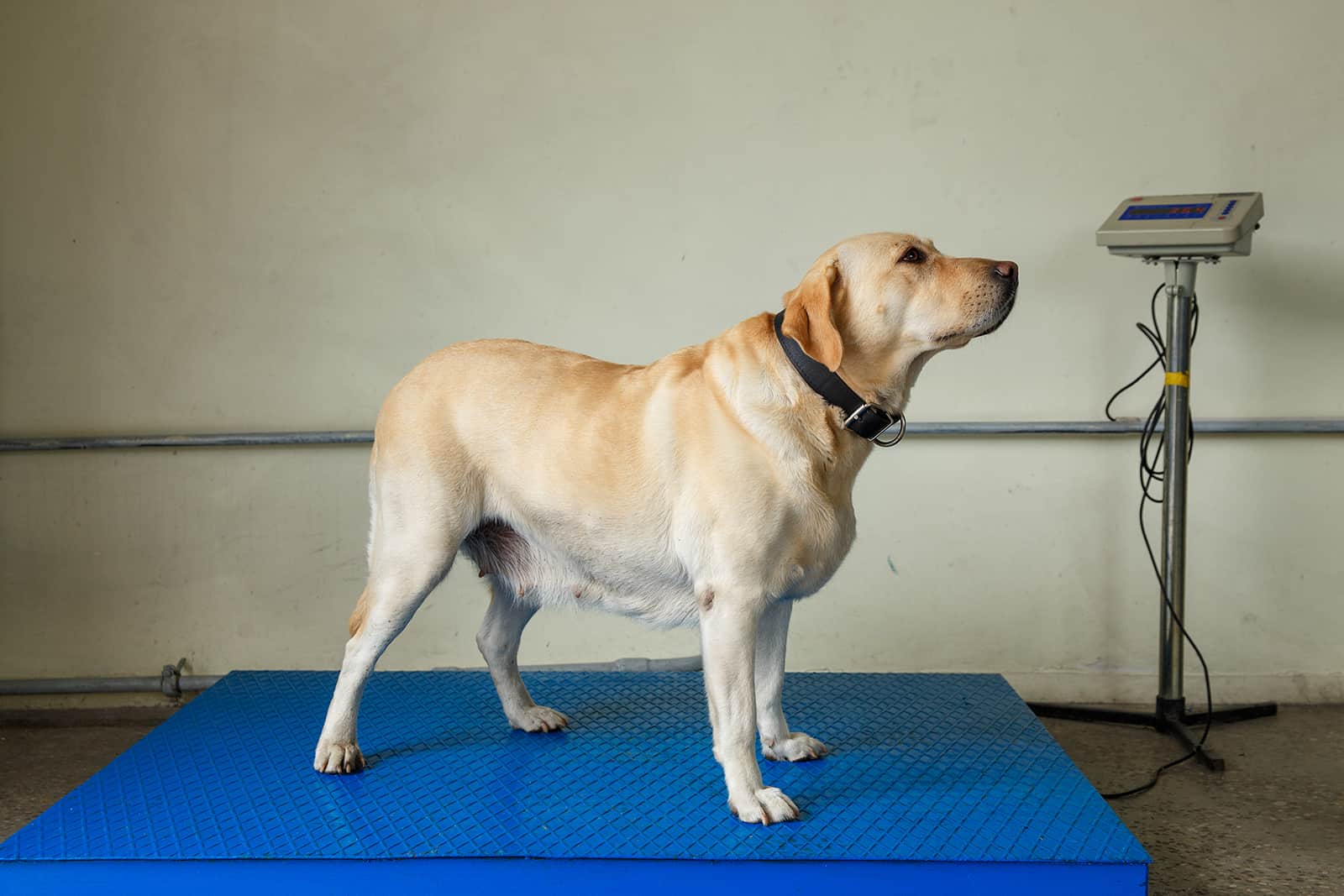
If you can’t afford to go to your vet all the time just to weigh your dog, or if it is perhaps too stressful for him, then you can weigh your dog at home by using a home scale.
If you own a very large dog, then it will be better to buy a dog scale that you can find online or at any larger pet store.
For very small dogs or puppies, the best is to use a baby scale because when it comes to their weight, even a quarter or half a pound is extremely important.
So, you have to place your scale on a flat, hard surface, preferably a bare floor or tiles, in order to get the best results and eliminate any possibilities of your pup getting hurt.
First, you need to weigh yourself alone, and write down that number so as not to forget it. Next, gently pick up your dog and record the weight of you two together.
Then, just simply subtract your weight from the one combined, and you will have your dog’s weight.
If it is possible, try to weigh your puppy early on as much as possible, so he can get comfortable with the habit.
You can also use positive reinforcement and reward him with a healthy treat every time he is a good boy, and everything passes without problems.
How Often Should You Weigh Your Dog?
By monitoring your dog’s weight, you will be able to keep him healthy and prevent obesity or any other health issue, so it is quite important to regularly weigh your dog, especially during its puppy stage.
Most veterinarians claim that an adult dog should be weighed every six weeks to a year. However, if you notice any change in his appearance or feeding habits, you can always start weighing him more regularly.
On the other hand, puppies should be weighed once a week until they are one year old.
Puppies need to be weighed more often because they grow so much during their first year, and their puppy weight should be monitored constantly in order to first see if they are developing normally, and second, to adapt properly to the amount of food they will be receiving.
How Heavy Is Too Heavy For A Dog?
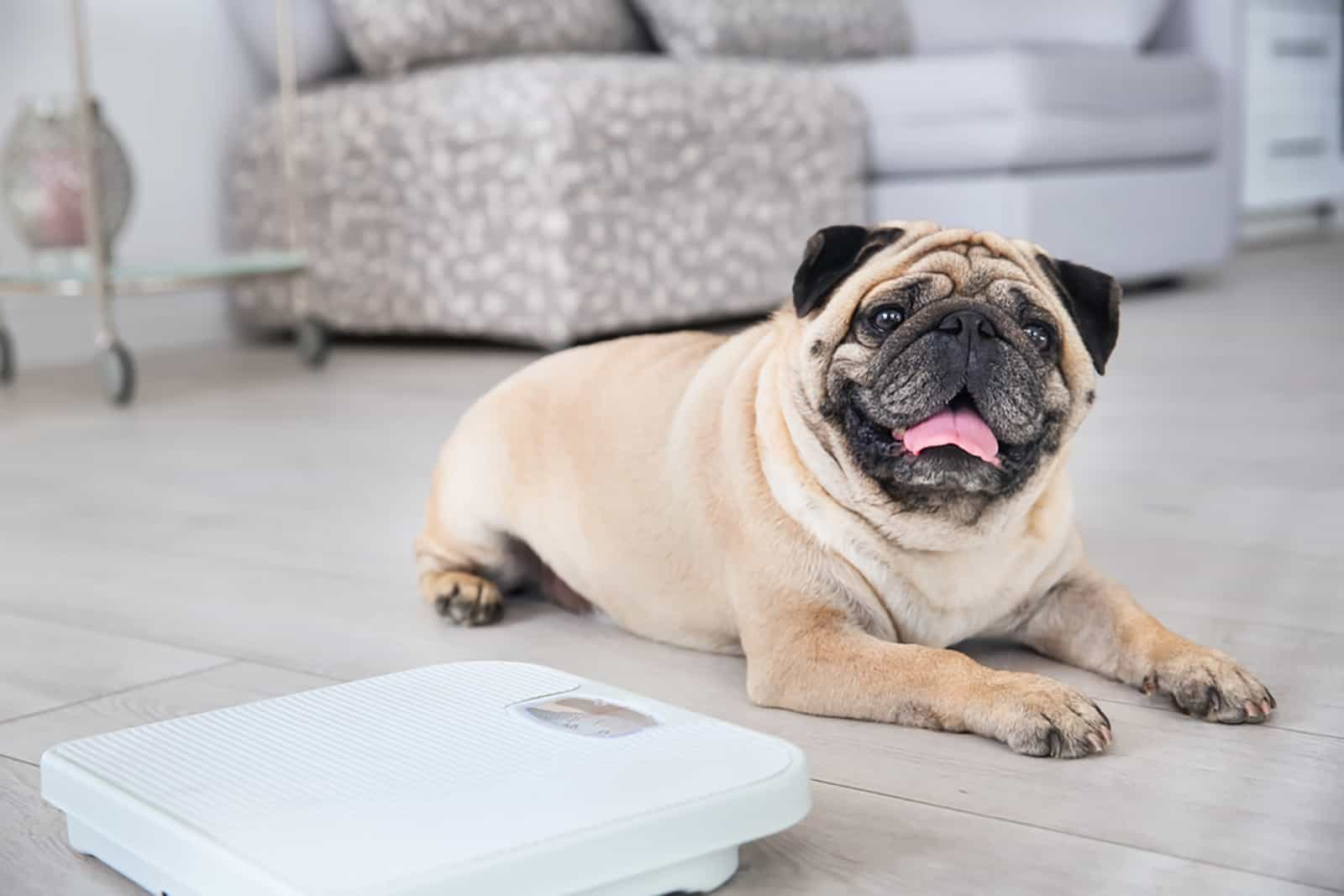
Obesity is one of the very serious problems that many dogs suffer from. It is estimated that approximately 50% of dogs in America are actually obese.
However, the good news is that it is easily preventable – you just have to be consistent and take care of your dog’s healthy habits.
So, what is obesity?
This is a health issue in the form of accumulation of excess body fat. Extra body weight goes hand in hand with excess fat.
A dog is said to be overweight when he is approximately 10% to 20% over his ideal body weight. In order for dogs to be considered obese, usually they will weight much more than the overweight amount, which is approximately more than 20%.
Obesity is not the only problem, but unfortunately, it also brings with it many other serious health issues.
Related: My Puppy Is Always Hungry – When To Stop Feeding
Health Issues Connected To Obesity
Shorter Lifespan
Obesity influences a lot concerning a dog’s lifespan and his quality of life in general. On average, it is said that an obese dog’s lifespan is shortened by two years compared to those dogs with normal adult weight.
The quality of life of overweight dogs is also much lower. They don’t get to experience all the joys of healthy, normal pups.
Usually, they have problems with walking, where they move slower or get tired very quickly. Laying down and napping is their preferred pastime.
Inflammation
Overweight and obese dogs have a much higher chance of different kinds of inflammation.
The hormones and other chemicals that are being stored in the fat tissue can cause or enhance the inflammation of different organs, which then can lead to other diseases.
Arthritis
When a dog is heavier than he should be, it puts a lot of pressure on his joints. When there is more stress on his joints, the cartilage starts to deteriorate, and all this can lead to arthritis.
Some signs of arthritis in dogs can include difficulty with standing from a lying position or difficulty going up stairs, or perhaps jumping on the bed or sofa.
There are some pain medications that can be used to ease the pain; however, the best solution is still weight loss.
Back Problems
If a dog is suffering from obesity, he or she is more prone to developing back problems and many other diseases that go along with it, such as Intervertebral Disc Disease or “slipped disc”, which can be treated either medically or surgically.
Heart And Breathing Problems
Weight gain is also often the cause of many heart diseases and breathing problems. High blood pressure, a collapsing trachea and Laryngeal paralysis are just some of the issues brought on by excess weight.
All of this, especially these breathing conditions, if not treated properly may lead to serious health issues and respiratory crises, which could be fatal. If you notice anything unusual, take your dog to the vet because it can save his life.
Read also: Why Is My Puppy Breathing So Fast? Rapid Breathing Explained
Skin Diseases
Overweight and a bit chunky dogs usually have those extra skin folds and rolls, which can sometimes be cute to see, but can also cause irritation and various bacterial infections.
The most common signs of infections are redness, itching, and body odor. Usually, these dogs will have a poor and unhealthy-looking coat because they are unable to take care of it properly.
Related: Pug Skin Problems: 8 Reasons Why Your Pet Feels Irritated
Cancer
Lastly, the most common cause of death in the canine world is cancer.
Overweight dogs and severely obese dogs have a much higher risk of certain tumors, such as lipomas (benign fatty tumors) and transitional cell carcinoma (breast and bladder cancer).
In order to prevent this, keep track of how much your dog weighs and how heavy your dog should be. A healthy lifestyle is the only way to a long and healthy life.
Read also: 15 Signs A Dog Is Dying: When Should You Say Goodbye?
Maintaining A Healthy Weight
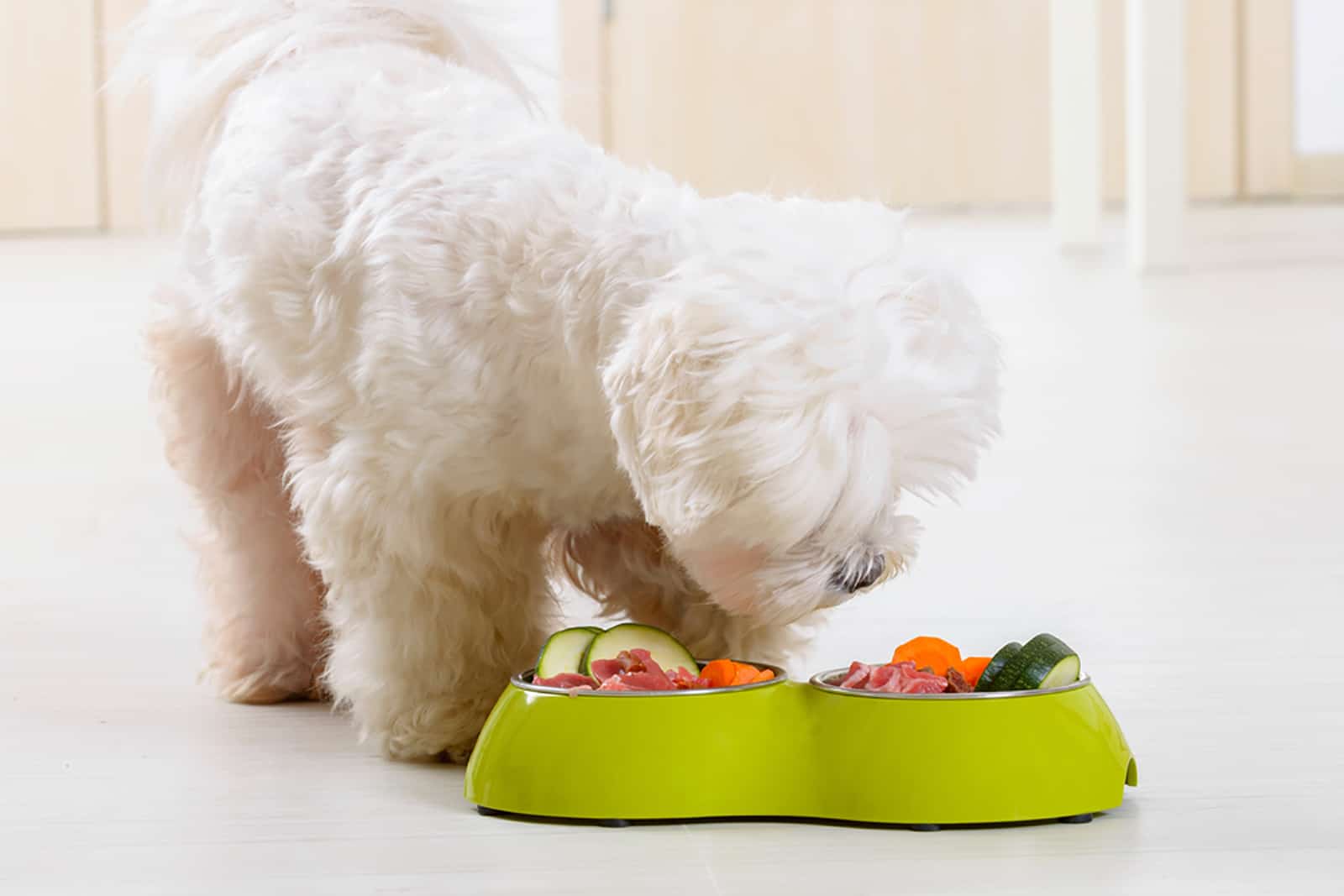
Maintaining a healthy weight is one of the most important steps in dog care. It is very important to keep track of your dog’s weight and any changes in his eating habits.
If you are still asking yourself, “how heavy should my dog be?”, or you don’t know how much you should be feeding him, the best would be to take your dog to be checked by a veterinarian.
He or she will assess your pup and guide you through the dog’s healthy diet and lifestyle.
If your doggo has some underlying issues that are causing him to be under or overweight, the vet will be able to diagnose them and hopefully treat them. Most likely, he will also put your dog on some special calorie diet that you will need to follow strictly.
Let’s see what some ways are that can help you maintain your dog’s healthy weight:
Healthy Diet
The best healthy diet for your little furry friend is the one that meets his nutritional needs. All dogs are different, and therefore, have different needs. Large dog breeds definitely have completely different needs than small dog breeds.
Although many dog owners choose dry kibble because of its convenience and less-expensive properties, wet food is usually more appropriate because it contains a higher protein and moisture content.
Read also: What Are The Worst Dog Food Brands On the Market?
Healthy Treats
Treats make up a big part of a dog’s diet. We all like to reward our pooches, especially when it comes to training and positive reinforcement, which is why it is important to offer them healthy options and not just empty calories.
There are many healthy treat options that you can find even in your kitchen that will be great for their health. Apples, carrots, watermelon, bananas, and blueberries are just some of the options.
Before you give your dog any new food, first try with small portions to make sure that your pup is not allergic to it, or a certain food that is not toxic to him.
Related: Can Dogs Eat Spicy Food? Find All The Facts To Keep Your Pet Safe
Physical Activity
Physical activity, as well as mental activity, is extremely essential in keeping your dog happy and healthy.
If dogs do not get enough exercise, not only do they get lazy, but they also get very bored, which can result in destructive behavior, like chewing, scratching, barking, or causing a ruckus.
Depending on your dog’s energy levels, you should take him out on daily walks to the dog park where he can run freely and play with other doggies. If your pup is a high-energy dog, maybe he will like going for hikes or running.
If your dog refuses to walk, then you need to motivate him somehow because daily walking is a very important activity that they shouldn’t miss.
Playtime
Every dog likes a little bit of playtime, and it is really important to try to incorporate it into their healthy lifestyle.
While choosing activities to play, try to choose ones where he would need to run a little bit, such as playing fetch, where he would need to be active while also enjoying some nice playtime.
To Sum Up
So, if you have been asking yourself, “how heavy should my dog be?”, we hope that we have been able to answer your question and help you a little bit.
Keep in mind that knowing how much your dog should weigh is not that easy to determine since there are a lot of factors that need to be considered such as their size, age, gender, health issues, etc.
The best way to determine if your dog is underweight or overweight is to use the Body Condition Score scale that many professionals also use, but if you are still uncertain as to whether you are doing everything right, feel free to visit your veterinarian and get professional help.
Related Content:
• Helpful Tricks For How To Stop A Dog From Eating Cat Food
• Why Do Dogs Eat Grass? Does Eating Grass Make Dogs Sick?











